|
Bride of Frankenstein
(1935)
Following the success of 1931's Frankenstein,
Universal immediately announced a sequel: The
Return of Frankenstein. First rumors surfaced in 1933, but it took two
more years until the finished film, now entitled Bride
of Frankenstein, was shown in theatres.
Synopsis:
The
film begins in a parlor, where Mary Shelley, Lord Byron and Percy Shelley
are having a chat. As they discuss the story of Frankenstein's Monster, Mary
reveals that this was not the end of the creature.
The
narrative then shifts to the burning mill from the first film. After the
burgomaster has sent all the people home, only an old couple, the parents
of the murdered girl Maria, are left. The husband plunges down into the ruins of
the mill where he discovers that the Monster is still alive. Driven by
revenge, the Monster kills the couple. Meanwhile Frankenstein is brought home to recover. There he
is visited by his old teacher Dr. Pretorius, who urges him to continue his
experiments. Pretorius brings Frankenstein to his own lab, where he shows
him his latest creations: five miniature men whom he keeps
in glass jars. Now Pretorius' aim is to build a bride for the monster in
order to "create a man-made race". Running loose in the woods,
the Monster spots a beautiful shepherdess and
approaches her. The frightened girl cries out in terror and falls into a lake, but
is saved from drowning by the Monster. Summoned by the girl's cries, two hunters
arrive and
shoot at the Monster. Soon a new lynch mob is organised and captures the Monster.
Killing several people, the Monster
manages to escape again. In
a forest hut he encounters a blind hermit, who is not afraid of the
horrible creature. He feeds the Monster, tends to his wounds and even teaches him
a few words. But this peaceful atmosphere does not last very long. Two
hunters discover the strange couple and chase the Monster away. The
creature then
hides in a graveyard where he meets Pretorius, who is just about to steal
some bodies. Together they drink wine and the Monster, pointing at a
skull, asks him, "You make man like me?" But Pretorius has
something better to offer, "No, woman, friend for you." The
doctor then uses the Monster to kidnap Frankenstein's bride Elizabeth in
order to make sure Frankenstein will co-operate. In Frankenstein's old laboratory
they finally give life to their new creation, a woman made from dead body
parts. When she spots the Monster, the bride is so appalled by his horrible appearance that
she rejects him. This final
disappointment is too much for the Monster to take and he destroys Pretorius, the Bride and himself. Before the building collapses he
proclaims, "You
live! We belong dead!" and sets
Frankenstein free to rejoin his wife Elizabeth. |
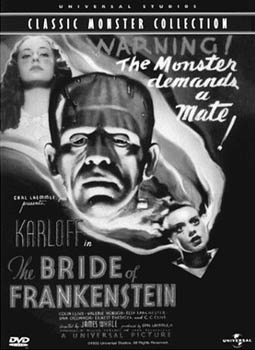
Cover of 1999 DVD release of Bride of
Frankenstein |
|
With a production budget of over $ 400,000 Bride
of Frankenstein, starring
Boris Karloff and Elsa Lanchester, was almost twice as expensive as its
predecessor.
Before the actual shooting began director James Whale
had to submit the
screenplay to the Motion Pictures Producers and Distributors Association (MPPDA). Under the pressure of
Joseph Breen and Catholic organisations like the League of
Decency, in 1934 the MPPDA had been forced to introduce
strict censorship rules, the so-called Production Code. This code
prohibited, among many other things, explicit depiction of crime, drug
abuse,
violence and sexual actions (e.g. "excessive and lustful kissing,
lustful embrace") in films. It also prohibited the use of indecent or
vulgar language, e.g. "S.O.B.", "damn",
"Hell!", "God!". While Frankenstein
had been left untouched by the censors on its initial release, Bride
of Frankenstein did not meet the approval of Joseph Breen.
"Throughout the script there are a number of references to
Frankenstein which compare him to God and which compare his creation of
the Monster to God's creation of Man. All such references should be
deleted." was one of Breen's statements (1). He also demanded the cutting of a scene where the Monster watches a couple
exchanging love vows and one scene depicting the killing of the burgomaster.
Additionally, the narrative frame lost much of the dialogue
of Mary Shelley, Percy
Shelley and Lord Byron boasting of their immorality and adultery. In fact, the narrative frame itself was introduced as a result of the strict
US censorship
system. James Whale feared that the film would be rejected because of
its Faustian theme and hints of blasphemy. Therefore he introduced the
narrative frame which should clearly point out that Bride
of Frankenstein exists explicitly as a work of fiction told in the
words of Mary Shelley.
In Trinidad, Palestine and Hungary the film was rejected
completely "simply because it is a horror picture" (2). Other countries (e.g. China, Singapore, Japan) deleted important parts of
the film and in Sweden censorship cuts were so excessive that Bride
of Frankenstein was only released as a short film. |
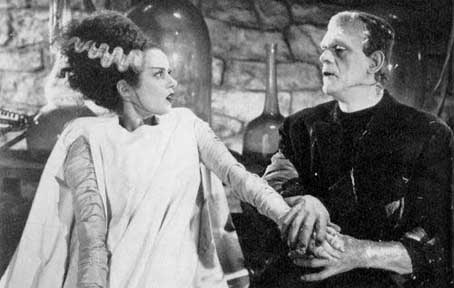
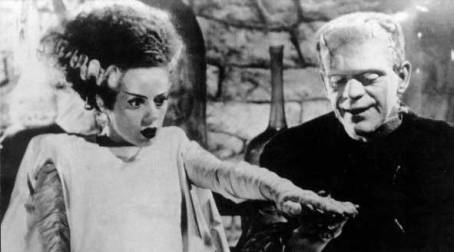
Beauty
and the Beast: the Monster meets the Bride (Karloff and Elsa Lanchester) |
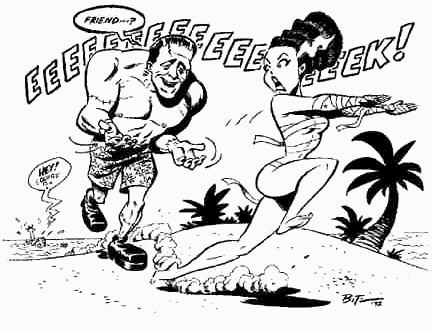
A Bride of Frankenstein cartoon by acclaimed comic book artist Bruce
Timm
One major difference between Frankenstein
and Bride of Frankenstein is the
conception of the Monster. While in Frankenstein
he was a murderous vengeful creature, the sequel presents a Monster the
audience can sympathise with, thus bringing him much closer to Mary
Shelley's original concept. Several scenes from the novel were adapted for
the film (the opening credits read "Suggested by the original story
written in 1816 by Mary Wollstonecraft Shelley and Adapted by William
Hurlbut, John Balderston") in order to make the Monster more human.
In one of them the Monster saves a girl from drowning and is
"rewarded" with being shot in the arm. Another, even more
important scene is the episode involving the blind hermit, which was obviously
influenced by the De Lacey episode from the novel. It is not only
important because for the first time a human being accepts the Monster, but
even more so because the Monster is given a voice. Now Frankenstein's
creation can talk and express his feelings and emotions through words.
Although his utterances are only simple sentences like "Friend -
good!" and not the eloquent speeches in perfect English from the
novel, this is an important factor in removing the Monster from the
sub-human image of the first film. Furthermore, the Monster can now be soothed
by sweet music, he laughs, drinks wine, puffs cigars with the hermit and
even weeps because at last he has found a friend. There are also hints at
a gay undertone inherent in these scenes, a guess which is not far-fetched
considering James Whale's homosexuality. "There is something tacitly but strongly
erotic here: the meeting of two men, both outcast, both unwanted, who find
they can share house under a common bond" (3).
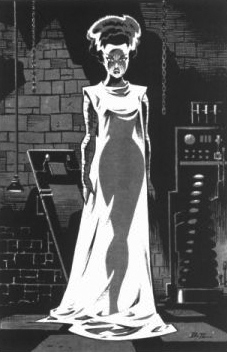
Another drawing of the Bride by Bruce Timm |
Very often the Monster is
clearly shown as a victim, which is a further step in order to humanise the Monster. The first such episode is the rescue of the
frightened shepherdess. In this scene we see the Monster in an idealised
idyllic setting with pine trees, mountains, sheep and a painted sky. This
is a sharp contrast to the preceding scene, that showed Pretorius and
Frankenstein in a dark, cold laboratory. Despite his noble act of rescuing
the drowning girl, the Monster is shot by hunters and runs off into the
woods. This tendency of victimizing the Monster is continued in one of the next scenes, where the
Monster is captured by the villagers. They chain him, tie him to a pole
"and raise him up in the air like a wounded Christ on the cross"
(4). Later, when the Monster has at last found peace in the
hermit's hut he again falls victim to the blind rage of the
villagers. When in the end the Monster enters the laboratory to see his bride
he appears like a sweet and innocent child. Smiling, he reaches for the
Bride and gently touches her hand whispering, "Friend." But the
Bride, monstrous like the Monster himself, rejects him and flees him in
terror. The ensuing rage of destruction is perfectly understandable
because now the Monster fully grasps all the consequences of his hopeless
situation: "She hates me, like others!" The Monster knows that
he will never have a chance in this world and that he will never be
accepted by anyone, not even those who are like him. There is only one
solution: suicide and the destruction of those who gave him life. But even in
this final act of destruction the Monster shows compassion and lets
Frankenstein escape.
|
To the Monster death is not necessarily the end but also symbolises
the source, a new beginning. He is aware that he was made up from dead parts
when he muses at a skull and says about Frankenstein, "I know him.
Made me from dead. I love dead. Hate living." When Pretorius promises
to make a wife for the Monster, he knows that "from the dead he was
made, among the dead he will find his companion, to the dead he will
return" (5)
In Bride of Frankenstein
Dr. Pretorius (the magnificent Ernest Thesiger) is a much more
important character than Frankenstein. He is the devil/Mephisto and
Frankenstein is Faust, the searcher for forbidden knowledge. By proposing
to make a bride for the Monster in order to "create a race, a
man-made race upon the earth", Pretorius is introduced as the true
evil force in Whale's film. In Shelley's novel it is the Monster who demands a
bride: "My companion must be of the same species and have the same
defects. This being you must create."
But here it
is Pretorius who brings up the idea to "create his mate". The Doctor's driving force is
a longing for power,
the wish to "populate the earth with his own handicraft"
(6) like a shadow God. The Monster in the novel, on the
other hand, only longs for someone to share his life with him.
On several occasions Pretorius is presented as a diabolical character. For instance, on
his first entrance Pretorius' name is spoken several times by Minnie and
Frankenstein. According to an old medieval superstition the devil's name
has to be spoken out aloud at least three times to invite him into human company. Like in Goethe's Faust
this has now been done and Pretorius/the devil will not leave
Frankenstein's side again. Pretorius then proposes a collaboration to
Frankenstein, to work together "not like master and student, but as
fellow scientists", again a reference to Faust.
|
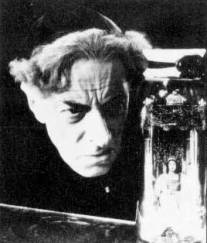
Diabolical capabilities:
Dr. Pretorius (Ernst Thesiger) |
When
Pretorius later shows Frankenstein his collection of miniature people in
glass jars he finally reveals his identity, or at least how he perceives himself. In one of the bowls we see a devil in a black suit and Pretorius
comments, "The next one is the very devil. Very bizarre, this little
chap. There is a certain resemblance to me, don't you think. Or do I
flatter myself ?"
Pretorius
again proves his "diabolical capabilities" (7) when he mysteriously enters Henry and Elizabeth's room through a backdoor
although Minnie has been ordered to send him away. Elizabeth tells him
that he is not welcome, but nevertheless exits the room to leave her
husband in the hands of the devil.
The duo of Pretorius and Frankenstein can also be interpreted as a gay
couple, who are still able to produce offspring, without any
participation of women. Film critic Gary Morris sees the whole film as a
gay assault on standard sex roles and family values. In his essay
"Sexual Subversion" Morris writes that Karloff's Monster is
"the terrifying child of
the unholy marriage of Pretorius and Henry — Henry the
father in giving it life, Pretorius a mother-figure who nurtures it".
He also points out several other instances that place Bride of
Frankenstein into a homosexual context, e.g. the fact that Ernst
Thesiger was gay.
Several scenes in Bride of Frankenstein
refer to an identification of the creator with his creation
and vice versa. When Henry Frankenstein's inanimate body lies on a table
in his castle this reminds of a similar scene of the Monster lying on a table in the
laboratory. When Henry suddenly moves his right hand - like the Monster in
the first film - Elizabeth cries out, "He's alive!", the same
phrase Henry madly yelled when he brought his creation to life. At the end
of the film the phrase will occur again when Frankenstein awakens the
Bride. In all three cases the return of dead persons to life is indicated
by the same gesture (moving of the hand) and the same announcement.
A number of
other points in the film also indicate the identification of creator and creation: Mary Shelley and the Bride are played by the
same actress (Elsa Lanchester); the Monster demands a mate at the same
time when Frankenstein marries Elizabeth; and the Monster takes
Frankenstein's place by kidnapping his bride Elizabeth.
This
is a parallel to a common tendency of confusing and mixing up the name
Frankenstein: Indeed to many people creator and creation have become synonymous, the Monster has become
Frankenstein, the name Frankenstein has become the name of the Monster - a
confusion that may also be caused by the title of the film. Even Dr.
Pretorius makes this mistake when he falsely introduces the female Monster
with the words "The Bride of Frankenstein!".
In addition to its horror elements, Bride
of Frankenstein also contains a number of humorous moments. In fact,
screenwriter Balderston stated that originally his script had been intended as
a satire but was later changed by Whale and producer Laemmle. The comic
highlights are Pretorius' miniature people in glass jars (a king madly in
love with the queen trying to get out of his jar, an archbishop wildly
whistling at the king to stop, a devil, a mermaid and a ballerina), the
Monster drinking wine and smoking cigars, and a couple of scenes involving
the burgomaster. Another such comic character is Una O'Connor's Minnie, a kind of Cassandra,
whom nobody believes when she warns of the Monster. Even Pretorius can
sometimes be funny, when he utters his running gag line, "It is my only
weakness", once referring to gin, another time to cigars.
In terms of film technique, Bride
of Frankenstein is a masterpiece of its time. Like in Frankenstein,
director James Whale took inspirations from German expressionism. The
design of the creation scene and the Bride's looks and robot-like
movements show influences from Fritz Lang's Metropolis. Elsa Lanchester
looks "half Neferiti, half ghost with her long white bridal gown"
8.
The creation scene, shot by
cinematographer John J. Mescall, is another extraordinary achievement. The room is filled with
various crackling and humming devices, among which Frankenstein and Pretorius restlessly run around flicking switches, adjusting machines and
giving orders to their assistants. This fast pace is underlined by
similarly fast editing: the sequence contains countless cuts with some shots shorter than one
second. Additionally, Frankenstein and Pretorius
are filmed from weird tilted angles, often in combination with wide-angle
close-ups of their faces, which gives the whole scene a restless,
almost outlandish tone.
Many viewers prefer Bride of Frankenstein
to is predecessor due to its more complex, multi-layered structure and its
unique, sometimes quirky mix of comedy, drama and horror. Both films are
undeniably genre-defining works and essential additions to the
Frankenstein universe, thanks to Boris Karloff's iconic impersonation of
the Monster and its re-interpretations of the Frankenstein myth.

|
Cast & Crew: |
|
| |
|
|
Henry Frankenstein |
Colin Clive |
| Elizabeth |
Valerie Hobson |
| Mary Shelley/The Bride |
Elsa Lanchester |
| The Monster |
Boris Karloff |
| Dr. Pretorius |
Ernest Thesiger |
| |
|
| |
|
| Make-up |
Jack Pierce |
|
Writing credits |
William Hurlbut,
John Balderston |
|
Music |
Frank Skinner |
|
Cinematography |
John Mescall |
| Producers |
Carl Laemmle jr |
| Director |
James
Whale
|
Footnotes: 1
Manguel, Alberto. Bride of Frankenstein. (London: British Film
Institute, 1997) 14
2 Manguel 1997: 15
3 Manguel 1997: 34
4 Manguel 1997: 30
5 Manguel 1997: 39
6 Manguel 1997: 27
7 Manguel 1997: 39
8 Manguel 1997: 46 ©
2000-2004
Andreas Rohrmoser


|


